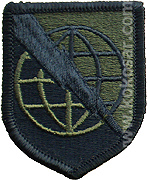
| US ARMY SIGNALS |
| JEDINICE VEZE KOPNENE VOJSKE |
|
|
|
Korpus veze Kopnene vojske SAD-a (United States Army Signal Corps) razvija, testira i upravlja komunikacionim i informatičkim sistemima za komande i kontrole kombiniranih oružanih snaga. Osnovani 1860 godine su „dijete“ majora KoV-a Alberta J. Myera i odigravala je važnu ulogu od Amričkogm građanskog rata do danas. Korpus ima i inicijalne odgovornosti za veći broj funkcija i novih tehnologija koje se trenutno nalaze pod upravom drugih vojnih organizacija, uključujući vojnu obavještajnu službu, meteorološku službu, avijaciju itd. |
||
 |
 |
|
|
The United States Army Signal Corps (USASC) develops, tests, provides, and manages communications and information systems support for the command and control of combined arms forces. It was established in 1860, the brainchild of United States Army Major Albert J. Myer, and has had an important role from the American Civil War through to the current day. Over its history, it had the initial responsibility for a number of functions and new technologies that are currently managed by other organizations, including military intelligence, weather forecasting, and aviation. |
||
|
9th ARMY SIGNAL COMMAND 9. KOMANDA VEZE KoV-a |
||
 |
||
|
1st SIGNAL BRIGADE 1. BRIGADA VEZE |
||
|
1. brigada veze, s motom „Prvi koji komuniciraju“ ("First to Communicate") je podređena 8. Armiji KoV-a SAD-a, stacionirana u Yongsanu, Južna Koreja. Osnovani su u Vijetnamu, 1966-te i na svom je vrhuncu brojala preko 22.000 pripadnika, raspoređenih u 6 Grupa veze (uključujući i 160. grupu veze), 22 bataljona veze i nekoliko komunikacijskih agencija, što ih je činilo najvećom jedinicom veze KoV-a u to doba. Krajem 1972. godine prebačeni su u Republiku Koreju, gdje su i danas pod upravom Strateške komunikacijske komande. |
||
 |
||
|
The 1st Signal Brigade ("First to Communicate") is a military communications brigade of the US Army subordinate to the Eight US Army and located at Yongsan Garrison in South Korea. The 1st Signal Brigade was activated on 1 April 1966 in the Republic of Vietnam. At the peak of the Vietnam War the brigade consisted of more than 21,000 soldiers, in six Signal groups (including the 160th Signal Group), 22 signal battalions and several communications agencies, making the 1st Signal Brigade the largest signal unit in the U.S. Army at the time. In November 1972 the brigade was relocated to the Republic of Korea under the U.S. Army Strategic Communications Command. |
||
|
3rd SIGNAL BRIGADE 3. BRIGADA VEZE |
||
|
3. brigada veze je sastavni element III korpusa Kopnene vojske SAD-a. Bili su smješteni u Fort Hood-u, u Teksasu, ali su reorganizacijom KoV-a u Snage modularne strukture 15. 04. 2008. godine deaktivirani. Od svojeg osnivanja 1946. godine, Treća briga je često bila gašena i ponovo osnivana. U svojem je sastavu imala brigadnu komandnu četu i 57 bataljon veze (uz mnoge druge jedinice koje su „poršle“ kroz ovu brigadu). |
||
|
The 3rd Signal Brigade of the US Army was an element of III Corps. It was based at Fort Hood, Texas, but was inactivated on 15 April 2008 as part of the transformation of teh US Army to a Modular Force Structure. The 3rd Signal Brigade has a history of inactivations and reactivations ever since formation of the unit in 1946. The 3rd Signal Brigade was composed of the Brigade's Headquarters and Headquarters Company & the 57th Signal Battalion. |
||
 |
||
|
Narandžasti štit visine 51 mm obrubljen bijelom bojom nosi u svom središtu plavu zvijezdu između tri bijele munje. Naradžasto i bijelo su boje Korpusa veze. Zvijezda podsjeća na Teksas, Državu usamljene zvijezde (Lone Star State) gdje je brigada i osnovana, a zvijezda ujdeno asocira i na postignuća i vodstvo. Munje predstavljaju brzinu veze, a svojim brojem aludiraju na naziv brigade. Plava boja predstavlja povezanost sa pješadijom i drugim borbenim jedinicama (plavo je boja pješadije). Znak je odobren 29. 08. 1979. |
||
|
On an orange shield 2 inches (51 mm) in width overall and within a 1/8 inch white border a blue star fimbriated white between three white lightning flashes. Orange and white are the Signal Corps colors. The star, a reference to Texas, the "Lone Star State," the place of initial activation, also refers to guidance and achievement. The flashes are symbolic of the speed of communications and also refer numerically to the present designation of the Brigade. The color blue is indicative of support to the Infantry and other combat forces. The insignia was approved on 29 Aug 79. |
||
|
7th SIGNAL BRIGADE 7. BRIGADA VEZE |
||
 |
 |
 |
|
11th SIGNAL BRIGADE 11. BRIGADA VEZE |
||
 |
 |
|
|
|
||
|
22nd SIGNAL BRIGADE 22. BRIGADA VEZE |
||
 |
 |
 |
| 440th SIGNALS BATTALION | ||
|
35th SIGNAL BRIGADE 35. BRIGADA VEZE |
||
 |
||
|
93rd SIGNAL BRIGADE 93. BRIGADA VEZE |
||
 |
 |
|
|
160th SIGNAL BRIGADE 160. BRIGADA VEZE |
||
 |
 |
|
|
261st SIGNAL BRIGADE 261. BRIGADA VEZE |
||
 |
||
|
OTHER INSIGNIAS OSTALE OZNAKE |
||
 |
 |
 |
| 11th SIGNALS BATTALION | 58th SIGNALS BN | 82nd SIGNAL BATTALION |
| BERET FLASH | ||
 |
 |
|
| 937th SIGNALS BATTALION | ||
|
|
||
| American military patch guide, J.L. Pete Morgan and Ted A. Thurman, 1997 | ||
|
Complete guide to the United States Army Medals, Badges and Insignia World War II to present, Cl. Frank C. Foster, 2004 |
||
|
ON TOP
|
||





